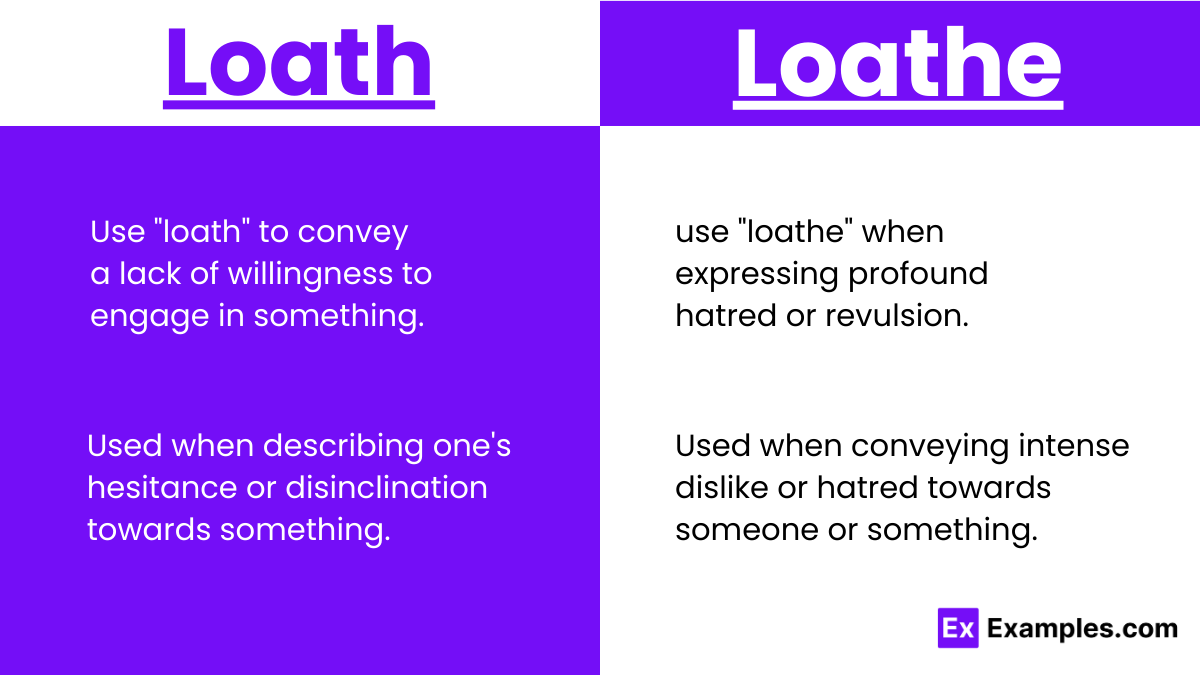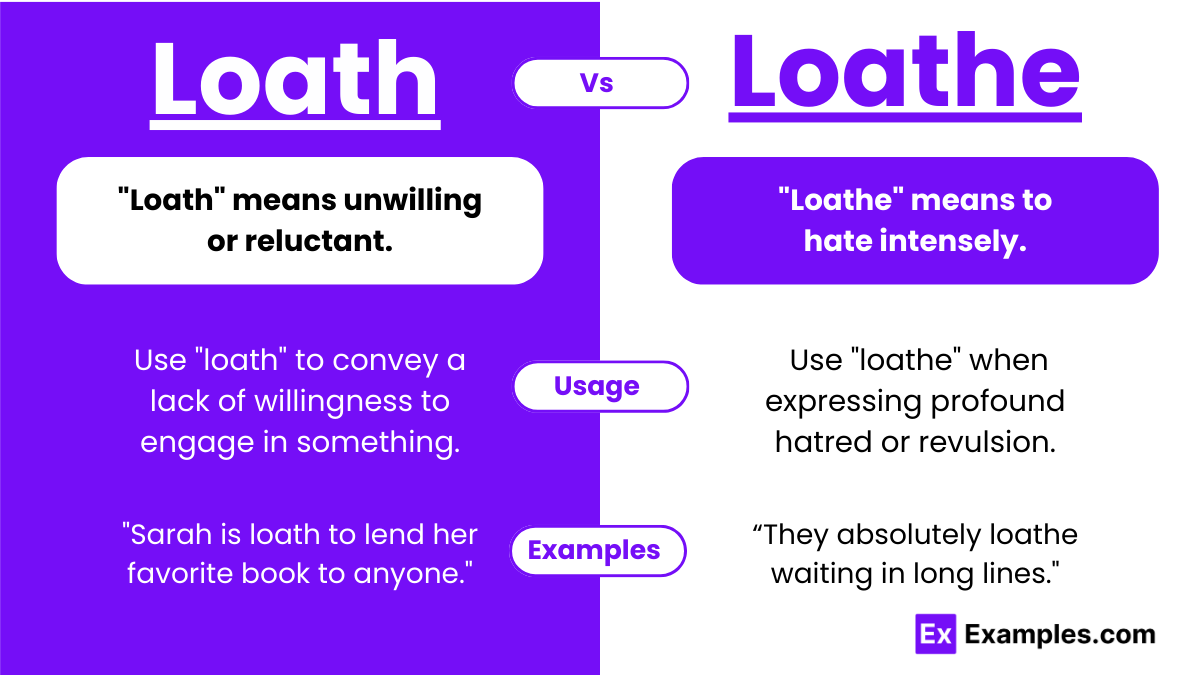Loath vs Loathe – Meanings, Differences, Usage, Examples
While they sound similar, they carry distinct meanings. ‘Loath‘ reflects an unwillingness or reluctance towards something, like being hesitant to attend a party. Conversely, ‘Loathe‘ expresses a strong dislike or dislike towards someone or something, akin to despising broccoli. One signifies hesitation, while the other conveys a deep-seated distaste.
Loath and Loathe – Meanings
- Loath: It is an adjective used to depict a sense of unwillingness or reluctance towards a particular action or situation. For instance, one might feel loath to engage in an activity they find uninteresting or unpleasant. It indicates a state of being hesitant or disinclined.
- Loathe: It is a verb that expresses a profound feeling of dislike or disgust towards someone or something. It signifies a strong aversion or repulsion. For example, one might loathe certain foods, behaviors, or individuals due to the intense negative feelings they evoke.
Summary
How To Pronounce Loath and Loathe
- Loath: Pronounced as /loʊð/.
- Loathe: Pronounced as /loʊð/.
Differences Between Loath and Loathe
| Aspect | Loath | Loathe |
|---|---|---|
| Application | Used when expressing a lack of eagerness or desire | Employed to convey a deep-seated dislike or hatred |
| Common Contexts | Found in situations where one is hesitant or unwilling | Used in contexts where there is strong dislike or aversion |
| Degree of feeling | Often indicates mild hesitation or reluctance | Typically conveys profound dislike or disgust |
| Frequency of use | Generally used in everyday language | May be used in more emotionally charged situations |
| Psychological impact | May imply a minor inconvenience or discomfort | Often suggests a deeper emotional response |
| Social implications | May be seen as a personal preference or opinion | Can indicate a strong stance against something |
| Cultural connotations | May vary depending on context and individual | Can carry cultural nuances or association |
How to Remember the Difference Between Loath and Loathe
Loath:
- Think of “loath” as representing a state of hesitation or reluctance. The word itself sounds somewhat slow or reluctant when spoken, with the elongated “o” sound.
- You can associate “loath” with being slow to act or being unwilling to do something. For instance, imagine someone dragging their feet to attend a party they’re not excited about. They are loath to go.
- The key here is the feeling of being unwilling or reluctant, like a hesitance or lack of eagerness.
Loathe:
- In contrast, “loathe” conveys a much stronger sentiment: intense dislike or aversion. The word itself sounds harsher, almost like a guttural reaction when pronounced.
- You can link “loathe” with a strong feeling of disgust or hatred. For example, imagine someone cringing at the mere thought of a particular food they despise. They loathe it.
- The emphasis here is on the depth of feeling, where there’s a profound dislike or aversion towards something or someone.
When To Use Loath and Loathe

Usage of Loath
- Reluctance or Hesitance: Employ “loath” when describing a feeling of reluctance or hesitation towards a particular action or situation.
- Unwillingness: Use “loath” to convey a lack of willingness or eagerness to engage in something.
- Mild Discomfort or Disinclination: It can also indicate a mild discomfort or disinclination towards something.
- Preference against: “Loath” may also imply a preference against something without necessarily expressing strong dislike.
Usage of Loathe
- Intense Dislike or Aversion: Reserve “loathe” for situations where there is a strong feeling of disgust or aversion towards someone or something.
- Hatred or Revulsion: “Loathe” is appropriate when expressing profound hatred or revulsion.
- Strong Emotional Response: It signifies a strong emotional response, often with physical discomfort or repulsion.
- Deep-Seated Dislike: “Loathe” is used to describe a deeply ingrained dislike or aversion.
Loath and Loathe – Examples

Loath Examples
- Sarah is loath to lend her favorite book to anyone.
- He’s always loath to ask for help.
- They were loath to leave the comfort of their home.
- She’s loath to leave her dog alone for too long.
- He’s loath to spend money on unnecessary things.
Loathe Examples
- He loathes getting stuck in traffic.
- She loathes the cold weather.
- He loathes having to repeat himself.
- They absolutely loathe waiting in long lines.
- Sarah loathes people who are rude to waiters.
Synonyms for Loath and Loathe
| Loath | Loathe |
|---|---|
| Reluctant | Abhor |
| Unwilling | Despise |
| Disinclined | Detest |
| Averse | Despise |
| Dislike | Abominate |
Exercises
- I am ____________ to confront him about the issue because I fear his reaction.
- She couldn’t hide her ____________ for the taste of raw onions in the salad.
- He’s always been ____________ to speak in front of large crowds due to his shyness.
- Sarah has a ____________ dislike for horror movies, refusing to watch them under any circumstances.
- She openly expressed how much she ________ dishonesty.
Answers:
- Loath
- Loathing
- Loath
- Loathing
- loathes
FAQ’S
Does “loath” mean to hate?
No, “loath” means unwilling or reluctant, not to hate.
Is “loathe” stronger than “hate”?
Yes, “loathe” is stronger than “hate,” indicating intense disgust or aversion.
Is “despise” or “loathe” worse?
“Loathe” is typically considered worse than “despise,” suggesting a stronger feeling of disgust or aversion.
Are there any specific grammatical rules to follow when using “loath” and “loathe”?
“Loath” is typically followed by “to” and the action or situation causing reluctance. Meanwhile, “loathe” is employed similarly to other verbs, requiring a subject and an object of intense dislike or hatred.


